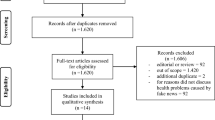Abstract
This study aims to assess and compare melanoma information quality in Hungarian, Czech, and German languages on the Internet. We used country-specific Google search engines to retrieve the first 25 uniform resource locators (URLs) by searching the word “melanoma” in the given language. Using the automated toolbar of Health On the Net Foundation (HON), we assessed each Web site for HON certification based on the Health On the Net Foundation Code of Conduct (HONcode). Information quality was determined using a 35-point checklist created by Bichakjian et al. (J Clin Oncol 20:134–141, 2002), with the NCCN melanoma guideline as control. After excluding duplicate and link-only pages, a total of 24 Hungarian, 18 Czech, and 21 German melanoma Web sites were evaluated and rated. The amount of HON certified Web sites was the highest among the German Web pages (19 %). One of the retrieved Hungarian and none of the Czech Web sites were HON certified. We found the highest number of Web sites containing comprehensive, correct melanoma information in German language, followed by Czech and Hungarian pages. Although the majority of the Web sites lacked data about incidence, risk factors, prevention, treatment, work-up, and follow-up, at least one comprehensive, high-quality Web site was found in each language. Several Web sites contained incorrect information in each language. While a small amount of comprehensive, quality melanoma-related Web sites was found, most of the retrieved Web content lacked basic disease information, such as risk factors, prevention, and treatment. A significant number of Web sites contained malinformation. In case of melanoma, primary and secondary preventions are of especially high importance; therefore, the improvement of disease information quality available on the Internet is necessary.
Similar content being viewed by others
References
Bosetti C, La Vecchia C, Naldi L, Lucchini F, Negri E, Levi F (2004) Mortality from cutaneous malignant melanoma in Europe. Has the epidemic levelled off? Melanoma Res 14:301–309
Garbe C, Leiter U (2009) Melanoma epidemiology and trends. Clin Dermatol 27:3–9
Forsea AM, del Marmol V, de Vries E, Bailey EE, Geller AC (2012) Melanoma incidence and mortality in Europe: new estimates, persistent disparities. Br J Dermatol 67:1124–1130
Risk A, Dzenowagis J (2001) Review of Internet health information quality initiatives. J Med Internet Res 3:E28
Babamiri K, Nassab RS (2010) The availability and content analysis of melanoma information on YouTube. Plast Reconstr Surg 126:51e–52e
Bichakjian CK, Schwartz LJ, Wang TS, Hall JM, Johnson TM, Biermann JS (2002) Melanoma information on the Internet: often incomplete—a public health opportunity. J Clin Oncol 20:134–141
Singh PM, Wight CA, Sercinoglu O, Wilasn DC, Boytsov A, Raizada MN (2007) Language preferences on websites and in Google searches for human health and food information. J Med Internet Res 9:e18
Berland GK, Elliott MN, Morales LS et al (2001) Health information on the Internet: accessibility, quality, and readability in English and Spanish. JAMA 285:2612–2621
Lawrentschuk N, Abouassaly R, Hackett N, Groll R, Fleshner NE (2009) Health information quality on the Internet in urological oncology: a multilingual longitudinal evaluation. Urology 74:1058–1063
Lawrentschuk N, Sasges D, Tasevski R, Abouassaly R, Scott AM, Davis ID (2012) Oncology health information quality on the Internet: a multilingual evaluation. Ann Surg Oncol 19:706–713
Kaimal AJ, Cheng YW, Bryant AS, Norton ME, Shaffer BL, Caughey AB (2008) Google obstetrics: who is educating our patients? Am J Obstet Gynecol 198:e1–e5
Couper MP, Singer E, Levin CA, Fowler FJ Jr, Fagerlin A, Zikmund-Fisher BJ (2010) Use of the Internet and ratings of information sources for medical decisions: results from the DECISIONS survey. Med Decis Mak 30:106S–114S
Ludgate MW, Sabel MS, Fullen DR, Frohm ML, Lee JS, Couper MP, Johnson TM, Bichakjian CK (2011) Internet use and anxiety in people with melanoma and nonmelanoma skin cancer. Dermatol Surg 37:1252–1259
Doré DF, Chignol MC (2012) Tanning salons and skin cancer. Photochem Photobiol Sci 11:30–37
Watson M, Holman DM, Fox KA, Guy GP, Seidenberg AB, Sampson BP, Sinclair C, Lazovich D (2013) Preventing skin cancer through reduction of indoor tanning: current evidence. Am J Prev Med 44:682–689
Corbett SW, White PD, Wittlake WA (2000) Benefits of an informational videotape for emergency department patients. Am J Emerg Med 18:67–71
Thomas R, Deary A, Kaminiski E et al (1999) Patients' preferences for video cassette recorded information: effect of age, sex and ethnic group. Eur J Cancer Care 8:83–86
Fogarty LA, Curbow BA, Wingard JR et al (1999) Can 40 seconds of compassion really reduce patient anxiety? J Clin Oncol 17:371–379
Horibe I, Satoh Y, Shiota Y, Kumagai A, Horike N, Takemori H, Uesato S, Sugie S, Obata K, Kawahara H, Nagaoka Y (2013) Induction of melanogenesis by 4′–O-methylated flavonoids in B16F10 melanoma cells. J Nat Med 67:705–710
Ye Y, Wang H, Chu JH, Chou GX, Yu ZL (2011) Activation of p38 MAPK pathway contributes to the melanogenic property of apigenin in B16 cells. Exp Dermatol 20:755–757
Marble N, Loescher LJ, Lim KH, Hiscox H (2010) Use of technology for educating melanoma patients. J Cancer Educ 25:445–450
Acknowledgments
This study was supported by the European Union and co-funded by the European Social Fund. Project title was “Telemedicine-focused research activities on the field of mathematics, informatics and medical sciences,” with project number: TÁMOP-4.2.2.A-11/1/KONV-2012-0073.
Author information
Authors and Affiliations
Corresponding author
Rights and permissions
About this article
Cite this article
Bari, L., Kemeny, L. & Bari, F. A Multilingual Assessment of Melanoma Information Quality on the Internet. J Canc Educ 29, 284–288 (2014). https://doi.org/10.1007/s13187-013-0596-4
Published:
Issue Date:
DOI: https://doi.org/10.1007/s13187-013-0596-4




